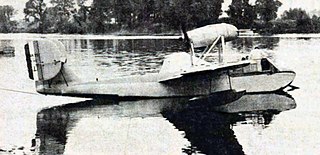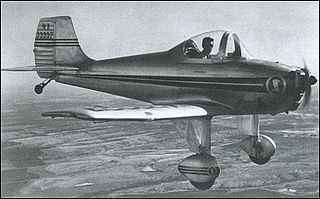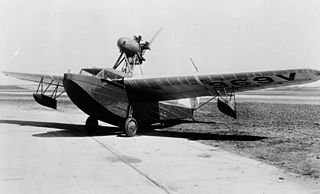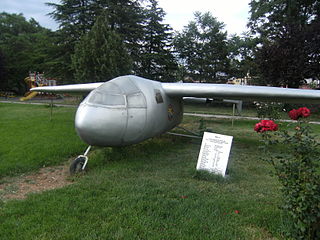Related Research Articles
The Aeronca Model 9 Arrow was a low-wing all-metal cabin monoplane with retractable landing gear. It was marketed to returning pilots from World War II and unveiled in 1947 but never went into production.
The Boisavia B.260 Anjou was a four-seat twin-engine light aircraft developed in France in the 1950s. It was a low-wing cantilever monoplane of conventional configuration with retractable tricycle undercarriage. Intended by Boisavia as a touring aircraft, it did not find a market and only the single prototype was constructed. At this point, the firm sold the design to SIPA, which modified the design and re-engined it with Lycoming O-360 engines, but found that they could not sell it either. At a time when the twin-engine light plane market was already dominated by all-metal American aircraft, the Anjou's fabric-over-tube construction was something of an anachronism, and all development was soon ceased. Plans to develop a stretched version with three extra seats and Potez 4D engines were also abandoned.

The Call-Air Model A is an American two- to three-seat utility aircraft designed by the Call brothers and built by the Call Aircraft Company, later developed into a successful line of agricultural aircraft.

The Colonial Model C-1 Skimmer was an American small single-engined amphibian flying boat built by the Colonial Aircraft Corporation. It was the start of a line of very similar aircraft designed by David Thurston.

The Goodyear GA-2 Duck was a 1940s American three-seat light amphibious aircraft built by the Goodyear Aircraft Corporation. The design team included David Thurston, who later developed several other light seaplanes including the Colonial Skimmer, Lake Buccaneer, Thurston Teal and Seafire. Only 19 aircraft were built, and these were used only for testing and as demonstrators.

The SCAN 20 was a 1940s French flying-boat training monoplane designed and built by Société de Constructions Aéro-Navales de Port-Neuf (SCAN). The prototype was built in secret in 1941. It was hidden until the liberation of France and first flown in 1945.

The Luscombe 10 was a single-seat sport aircraft built in the United States in 1945. It was a conventional, low-wing cantilever monoplane with fixed, tailwheel landing gear, designed for aerobatics. The wings, tail unit, and engine section were all adapted from the Luscombe 8, while the fuselage center section was an all-new design, relocating the Model 8's wings from a high to low position.

The SECAN SUC-10 Courlis was a French high-wing touring monoplane designed and built by Société d'Etudes et de Construction Aéronavales (SECAN), a branch of the automobile company Société des Usines Chaussons. The aircraft had problems with the engine installation and only 144 were built, some without engines and were scrapped.

The Curtiss Model 57 Teal was an American monoplane amphibian designed and built by the Curtiss Aeroplane and Motor Company. Two versions were built, a three-seater and four-seater but only one of each was built.

The Beecraft Queen Bee was an American V-tailed four-seat cabin monoplane, designed and built by Bee Aviation Associates (Beecraft).
The Beriev MBR-7 was a Soviet short-range reconnaissance/bomber flying boat developed by the Beriev design bureau at Taganrog. Designed as a successor to the MBR-2 but it did not go into production due to lack of engines.
The Nord 2100 Norazur was a 1940s French military transport monoplane designed and built at Courbevoie near Paris by SNCAN.

The Baumann Brigadier was a prototype American light transport aircraft of the late 1940s. It was a twin-engined monoplane, which, unusually, was of pusher configuration. Only two were built, plans for production never coming to fruition.

The Douglas Cloudster II was an American prototype five-seat light aircraft of the late 1940s. It was of unusual layout, with two buried piston engines driving a single pusher propeller. Only a single example was built, which flew only twice, as it proved too expensive to be commercially viable.

The Waco E series is a small family of American-built cabin biplanes built between 1939 and 1942, which differed primarily by engine installation.
The Udet U 11 Kondor was a German four-engined airliner designed and built by Udet Flugzeugbau, only one was built.

The Kreider-Reisner Midget was an American light racing monoplane, the first aircraft designed by the Kreider-Reisner Aircraft Company of Hagerstown, Maryland.

The Elias EC-1 Aircoupe was an American two-seat parasol wing monoplane designed and built by Elias of Buffalo, New York.
The Aristocraft II was a six-place homebuilt aircraft designed by Terrence O'Neill.

The THK 11 was a 1940s prototype Turkish four-seat monoplane, designed by Stanisław Rogalski and built by Türk Hava Kurumu.
References
Notes
- 1 2 3 4 5 6 Orbis 1985, p. 3077
- ↑ O'Neill, Terry. "The Last Waco". Sport Aviation. No. March & April 1964. Retrieved 14 November 2022.
- ↑ "Waco". www.aerofiles.com. 26 April 2009. Retrieved 3 April 2010.
- ↑ Bridgman, Leonard, ed. (1947). Jane's all the World's Aircraft 1947. London: Sampson Low, Marston & Co. pp. 296c–297c.
Bibliography
- The Illustrated Encyclopedia of Aircraft (Part Work 1982-1985). Orbis Publishing.
- Simpson, R.W. (1991). Airlife's General Aviation. England: Airlife Publishing. ISBN 1-85310-194-X.